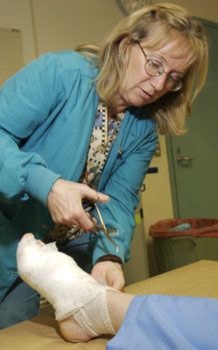Robots may figure prominently in nursing’s future, but the high-tech helpers won’t be enough to stave off a rural nursing shortage, says Michael Villeneuve.
In the Yukon, there are 310 registered nurses. That’s already too few.
But the situation will grow worse by 2020 unless the nursing industry reinvents itself, internally and publicly.
Villeneuve is a scholar-in-residence at the Canadian Nurses Association.
In 2006 he co-produced a lengthy report on options for the future of nursing in Canada.
On Saturday, he’ll deliver an hour-long update on his work since 2004 to Whitehorse nurses.
He has gained attention in the past for spicing up his presentation with sci-fi musings on a high-tech future, when a shortage of nurses could be countered with cybercare.
“His presentation can be quite controversial,” said registered nurse Patricia McGarr, executive director of the Yukon Nurses Association.
“In the future, in 2020, we may even have non-human caregivers. Robots. How is that going to work out and how are people going to react to that?”
The future is a nice hook, said Villeneuve.
“When I do the hour presentation, which is really a tease to get people to read the report, you have to make it interesting,” he said.
“I always show some robotics as one solution to extend our reach.”
For example, a grocery store checkout station could scan your milk and eggs, along with your blood pressure and cholesterol, he said, outlining one future scenario.
Your cholesterol level indicates that the store should deny selling you the eggs. Your receipt for the milk directs you to the in-store nursing clinic for dietary consultation.
Privacy and freedom issues aside, Villeneuve’s picture of a possible future lays out possible changes in the role of nursing.
“We need to devolve nursing from hands-on passing of medication to people in hospitals with an idea that nurses can contribute to health and can do it in other places,” he said.
In the future, nurses will possibly take over prescription and diagnosis duties from family doctors and general practitioners, said Villeneuve’s report.
Already, a doctor shortage is leaving many Yukoners dependent on clinics for primary care.
More and more surgeries may become unnecessary with proper preventative care and medication, or may simply become less invasive, moving to outpatient clinics and freeing up hospital nursing resources, said Villeneuve.
In an imagined future, patients won’t need referrals to specialists.
“You would have a range of health professionals providing gateways to health care,” he said. “You could access a physiotherapist, or an occupational therapist, or a dietitian directly without needing a referral.”
Of course, many of the systemic changes needed to stem health care’s drain on other social programs must include incentives for people to become employed by the system.
The real issue for Yukoners is the nursing shortage.
“Nurses are getting older, like the rest of the population,” McGarr said.
The average age of a nurse in Canada is now 47, said 48-year-old Villeneuve, an RN himself.
According to his data, for every nurse under 35 there are two over 50.
In addition to an aging workforce, Yukoners face the consequences of a global trend; the migration of skilled workers from rural to metropolitan centres.
Census data from 2006 confirms that more than 80 per cent of Canadians live in urban centres. Villeneuve hasn’t seen any evidence that the situation will turn around by 2020.
“There’s almost no incentive high enough to get serious volumes of people to want to go to work in small communities, whether its rural Ontario, rural Nova Scotia, or rural Yukon.”
Liberal MLA Arthur Mitchell recognized the value of rural outpost nurses in legislature this week, in conjunction with the start of National Nursing Week.
He lived in small-town Yukon for 20 years before moving to Whitehorse.
“Rural Yukoners may have much more frequent contact with a nurse than with a doctor,” Mitchell said.
“In our family, most of my wife’s prenatal care was provided by the Red Cross outpost nurse who served in Atlin during the 1970s.
“She (the nurse) was also the person who provided the first medical care following accidents in that community, and she sometimes was even called upon to provide veterinary services.”
To increase First Nation medical access, Ottawa set aside $100 million over five years for an aboriginal health human resources initiative.
The idea is that First Nation health practitioners will return to their rural communities.
It is an unreasonable expectation, said Villeneuve.
A quick online job search revealed that the Yukon government is trying to fill nursing vacancies in Carcross, Carmacks, Faro, Mayo and Whitehorse General Hospital.
Some, including Villeneuve, pitched telemedicine as a possible answer to the nursing shortage in remote communities.
Today, he’s not so sure.
“One of the worries about that (video-consultation) is that it also removes the need for actual humans to go to those small communities,” said Villeneuve.
“The technology can be even more of an isolating factor.”
Toward 2020: Visions for Nursing is a free talk at 1 p.m. on Saturday, May 12th, at the High Country Inn in Whitehorse.
